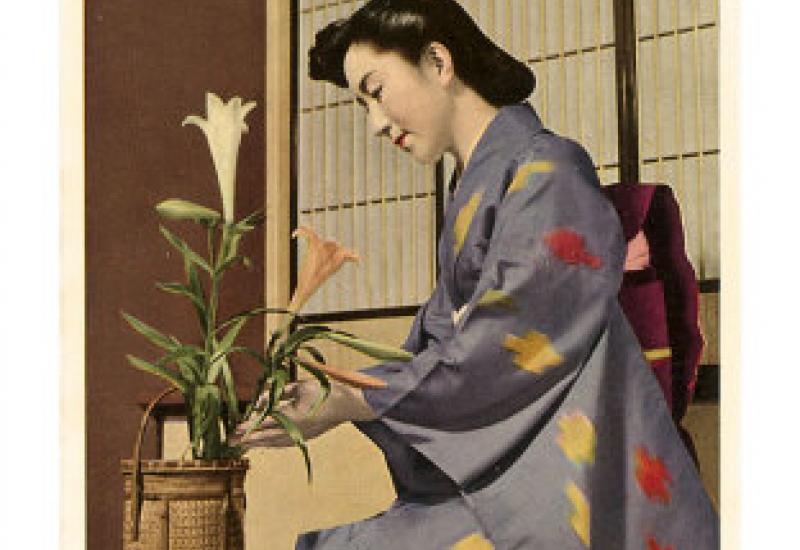Sometimes you can hear from the "experts" that Ikebana is a composition of dried flowers. However, it is not so! The word "Ikebana" consists of two hieroglyphs, their translation from Japanese means «live flowers" that is Ikebana - a composition of fresh flowers in a vase.
But what is a difference between Ikebana and European flower arranging?
First, the Japanese flower arrangement is not only aesthetic canon, but also has philosophical principles, deep symbolism, ancient traditions. In traditional Ikebana, each composition is not just shows the beauty of geometric forms and combinations of bright colors, but also has its philosophical meaning.
The history of ikebana has more than 500 years and is inextricably linked with the history of the Ikenobo School. This traditional school was founded in the XV century in the city Kyoto in Buddhist temple Rokkakudo. There were 45 generations of monks, which wore the name Ikenobo, leading school of the same name. Composing great songs, teaching others, they started ikebana and in an unbroken tradition brought the art to this day.
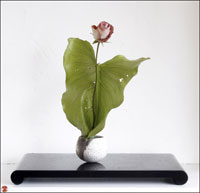 For a long time exclusively male professionally engaged in Ikebana, like in other traditional arts.But at the end of XIX century the situation has changed, and now there are 90% of women among those involved in Ikebana. Often contemporary Japanese girl before marriage for several months is studying traditional art - ikebana, tea ceremony, calligraphy, learning to dance, cook traditional dishes. But after a couple months of training on can get only some skills and general notions, because to become true master in such a short time is practically impossible - it takes years and decades...
For a long time exclusively male professionally engaged in Ikebana, like in other traditional arts.But at the end of XIX century the situation has changed, and now there are 90% of women among those involved in Ikebana. Often contemporary Japanese girl before marriage for several months is studying traditional art - ikebana, tea ceremony, calligraphy, learning to dance, cook traditional dishes. But after a couple months of training on can get only some skills and general notions, because to become true master in such a short time is practically impossible - it takes years and decades...
Even a brief touch to the world of beauty and exquisite leaves a trace in the soul of human, changes it, teaches to see the beauty in ordinary things.
When you begin to engage in Ikebana, it begins to change view on the environment - trees, flowers ... All of a sudden you start to notice which kind of plants grow near your home; you begin to distinguish between them. You started to understand, for example, that maple on the streets of Kyiv has many species that differ in shape and color of leaves, different flower.
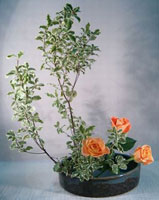 And you will have another attitude to those “geometric” bouquets from the market, to bouquets of roses on long stems ..
And you will have another attitude to those “geometric” bouquets from the market, to bouquets of roses on long stems ..
The nature is reflected in Japanese Ikebana: every classic composition includes mini landscape, forest glade with high trees, medium bushes, low herbs and flowers. That is why Ikebana is asymmetric, because in nature nothing is static, everything is moving, changing. When all the flowers are of equal length - it is "greenhouse" and not natural "lawn".
"Traditionally we use branches and flowers to create the perfect image of the inner beauty of plants - an image based on the natural form of flowers and trees growing in the fields, woods, near the lake. This way you should treat the flowers ... "
(Ikenobo Sen’ey, founder of the school Ikenobo, 1462)
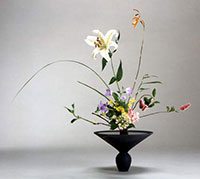 However, ikebana arrangement is not just the landscape, on the symbolic level it is a microcosm, a universe in miniature. Each classical form is shown philosophical principle Trinity World - the three main elements of the composition symbolizes the sky (larger element), Earth (smaller) and human (middle). Often branches are used as basic elements, and flowers are assistants.
However, ikebana arrangement is not just the landscape, on the symbolic level it is a microcosm, a universe in miniature. Each classical form is shown philosophical principle Trinity World - the three main elements of the composition symbolizes the sky (larger element), Earth (smaller) and human (middle). Often branches are used as basic elements, and flowers are assistants.
In traditional Japanese house, ikebana was placed in a special niche-tokonoma, where the scroll with calligraphy was hung and there were various interesting trinkets. Tokonoma was used as aesthetic center of home; the guests approached it first to enjoy the things that have prepared for them the host. Guest sat on the mat and bowed lowly to subjects. Then he slowly raised his eyes, respectfully considering the whole composition. The light from the side windows gently outlined some elements, while others were hidden in the shadows.
Classical Ikebana always is clearly oriented with respect to natural light. Each composition is clearly expressed yang (light and rigid, male) and Yin (dark and soft, female) elements, i.e. their rules for constructing light and shadow.
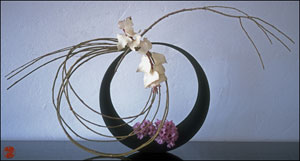 In modern apartments, there is no niche-tokonoma, so the composition of flowers is arranged according to the interior. If to put a vase on a high shelf close to the wall, the composition, in which one of the branches hanging forward, will be looked well. Ikebana on the table middle of the room should be well decorated on all sides, but there is always the priority direction from which it is better to see.
In modern apartments, there is no niche-tokonoma, so the composition of flowers is arranged according to the interior. If to put a vase on a high shelf close to the wall, the composition, in which one of the branches hanging forward, will be looked well. Ikebana on the table middle of the room should be well decorated on all sides, but there is always the priority direction from which it is better to see.
The Japanese prefer not durable ikebana to artificial flowers. After all, its fragility makes realize the transience of human life, causes acute sense of the uniqueness of the moment, teaches to appreciate the beauty of nature. Live cut flowers as trusted themselves to the people asking to extend their short life and create a new beauty, combining them with other plants.
"We are creating a flower arrangement, and not just" put "them. It means to detect the inherent beauty of flowers, and at the same time reveal the beauty of your own soul. Ikebana is our search for ideal beauty. "

